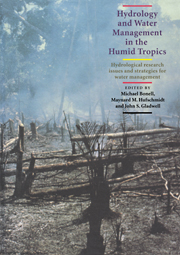 Hydrology and Water Management in the Humid Tropics
Hydrology and Water Management in the Humid Tropics Book contents
- Frontmatter
- Contents
- List of Authors
- Foreword by Federico Mayor, Director-General, UNESCO
- Preface
- Cartographic Credit
- Acknowledgements
- SECTION I INTRODUCTION
- SECTION II HUMID TROPICS SETTING
- SECTION III REGIONAL HYDROLOGY
- SECTION IV PHYSICAL PROCESSES
- SECTION V PHYSICAL PROCESSES – HUMAN USES: THE INTERFACE
- SECTION VI MANAGEMENT ISSUES
- SECTION VII APPENDICES
- Appendix A Definition of the Humid Tropics
- Appendix B Workshop Reports
- Appendix C Committees for the ‘International Colloquium on the Development of Hydrologic and Water Management Strategies in the Humid Tropics’
- Appendix D Organizations Supporting UNESCO and UNEP in the presentation of the Colloquium
- Place index
Appendix A - Definition of the Humid Tropics
Published online by Cambridge University Press: 23 December 2009
- Frontmatter
- Contents
- List of Authors
- Foreword by Federico Mayor, Director-General, UNESCO
- Preface
- Cartographic Credit
- Acknowledgements
- SECTION I INTRODUCTION
- SECTION II HUMID TROPICS SETTING
- SECTION III REGIONAL HYDROLOGY
- SECTION IV PHYSICAL PROCESSES
- SECTION V PHYSICAL PROCESSES – HUMAN USES: THE INTERFACE
- SECTION VI MANAGEMENT ISSUES
- SECTION VII APPENDICES
- Appendix A Definition of the Humid Tropics
- Appendix B Workshop Reports
- Appendix C Committees for the ‘International Colloquium on the Development of Hydrologic and Water Management Strategies in the Humid Tropics’
- Appendix D Organizations Supporting UNESCO and UNEP in the presentation of the Colloquium
- Place index
Summary
The humid tropics can be defined in different ways, depending on the objectives. The three best known approaches may be briefly summarized.
Köppen classification. Wladimir Köppen, German biologist, was the pioneer of climatic classification with his original work being published in 1900 and revised in 1936.
Köppen presented formulas, which included monthly temperature and rainfall data, to delineate arid (desert) and semiarid (steppe) climates. Outside the arid and semiarid zones, all climates are forest climates, except in polar regions and high mountains where low temperatures prohibit the growth of trees.
Within the forest climates, three major types are recognized according to temperature. Köppen's tropical climate (A climate) includes areas where the mean temperature of the coldest month exceeds 18°C, the optimum temperature for human comfort. The 18°C isotherm also agrees well with the distribution of palm trees, a typical tropical plant.
The A climate has three sub-types: Af (tropical rain forest), Am (monsoon forest), and Aw or As (savanna). In the Af climate, monthly rainfall exceeds 60 mm throughout the year. In the Am climate, the dry season is either very short or the rainfall during the wet season is copious. Both the Aw and As climates have a distinct dry and wet season, with the dry season occurring during the winter and summer, respectively. However, the As climate has a limited distribution.
Some climatologists consider all A climates to be humid tropical since they occur outside the arid and semiarid zone. Köppen's Aw climate, however, is too extensive and consequently includes a wide range of ecological and agroclimatic zones.
- Type
- Chapter
- Information
- Hydrology and Water Management in the Humid TropicsHydrological Research Issues and Strategies for Water Management, pp. 571 - 574Publisher: Cambridge University PressPrint publication year: 1993
- 21
- Cited by
